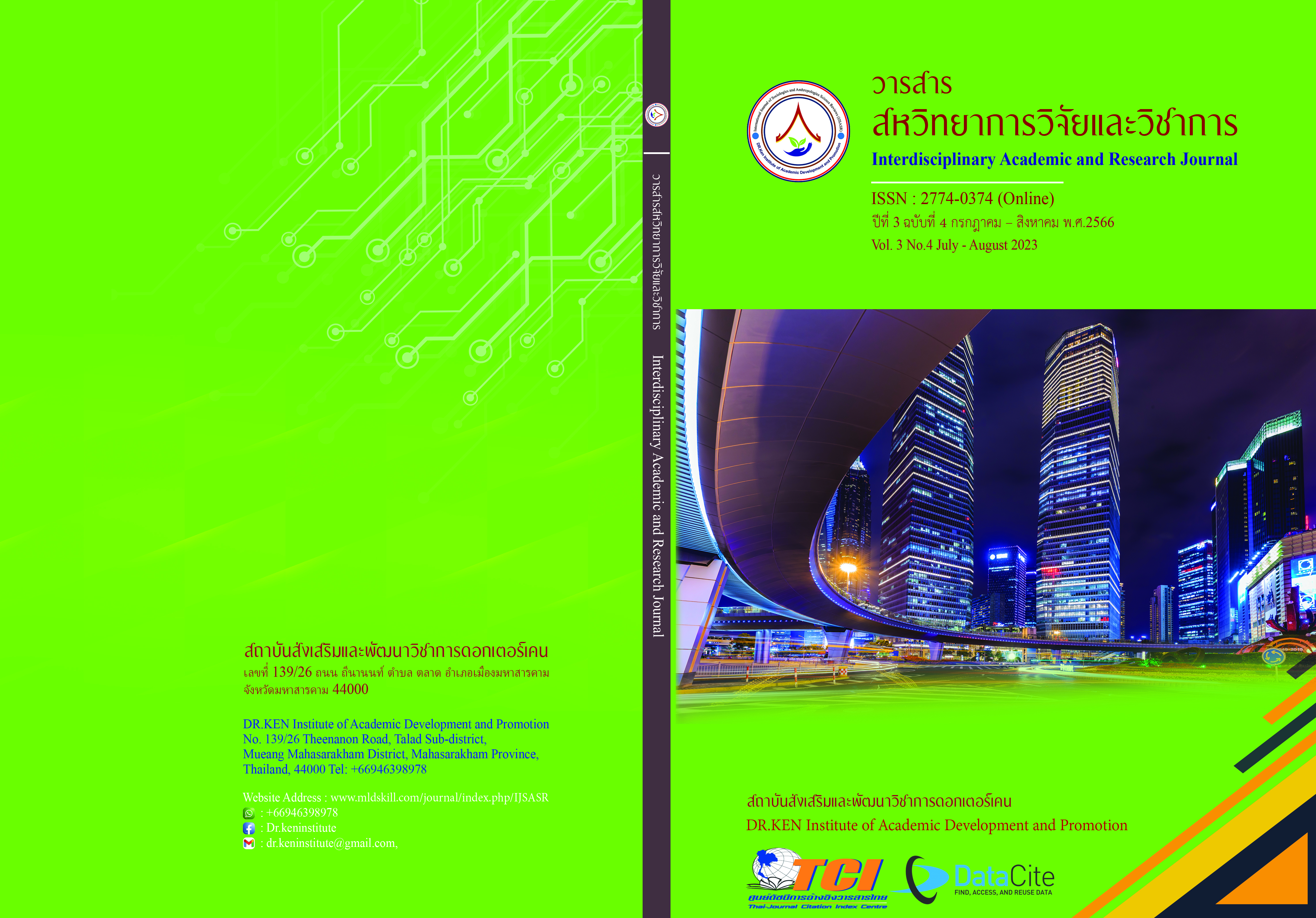The Effects of Learning Provision by Using Multimedia Activity Package with Role Play to Promote Self-Esteem in Young Children
DOI:
https://doi.org/10.14456/iarj.2023.222Keywords:
Learning Provision; , Multimedia Activity Package; , Role Play; , Self-esteem; , Young ChildrenAbstract
The management of learning by using a series of mixed media activities and role-plays for children to demonstrate their abilities. It is a creative activity that results in early childhood development in terms of physical, emotional, social, and intellectual development. It is also an ethical learning that helps children discover themselves, understand themselves, and can project their future. Thus, this study aims to study the effects of learning provision by using a multimedia activity package with role play to promote self-esteem in young children. The target group was 16 male and female young children aged between 5-6 years old, studying in kindergarten level 3 in semester 2 of the academic year 2022, Banmabfugtong School, Huay Yai sub-district, Banglamung district, Chonburi province under Chonburi Primary Educational Service Area Office 3, The research instrument included 24 plans of learning experience provision using multimedia activity package with role play and an assessment form on self-esteem in young children. The quantitative data were analyzed by mean and standard deviation. The qualitative data were analyzed by content analysis. The research findings revealed that young children who participated in learning experience provision with a multimedia activity package with role play had higher mean scores of self-esteem than those who did not. The highest mean scores were self-confidence and self-esteem, respectively.
References
ขนิษฐา บุนนาค. (2561). การเล่นบทบาทสมมติ (Role Playing) กิจกรรมสร้างสรรค์สำหรับเด็กปฐมวัย. Retrieved on December 30, 2022 from: https://www.youngciety.com/article/learning/role-playing.html
ณัฐรุจา ท่าโทม. (2565). ผลการใช้กิจกรรมบทบาทสมมติเพื่อเสริมสร้างพฤติกรรมทางสังคมของเด็กอนุบาลในห้องเรียนพหุวัฒนธรรม. วิทยานิพนธ์การศึกษามหาบัณฑิต สาขาวิชาการศึกษาปฐมวัย :มหาวิทยาลัยบูรพา.
ณิชาบูล ลำพูน. (2560). การพัฒนาโปรแกรมกิจกรรมศิลปะโดยใช้ทีมเป็นฐาน เพื่อส่งเสริมการเห็นคุณค่าในตนเองของเด็กและเยาวชนในสถานสงเคราะห์. วิทยานิพนธ์การศึกษาครุมหาบัณฑิต, จุฬาลงกรณ์มหาวิทยาลัย.
นิธินันท์ ชารีชุม. (2563). กิจกรรมบทบาทสมมติกับการสอนภาษาอังกฤษสำหรับนักเรียนนายสิบตำรวจ.วารสารลวะศรี มหาวิทยาลัยราชภัฏเทพสตรี. 4(1), 101-108.
รัชนีกร ชะตางาม. (2560). การสร้างสรรค์ศิลปะสื่อผสมพื้นที่แห่งความสุข กรณีศึกษาศิลปะบำบัด เพื่อพัฒนาสมาธิในเด็กสมาธิสั้น. วิทยานิพนธ์การศึกษาตามหลักสูตรศิลปมหาบัณฑิต สาขาวิชาศิลปะการออกแบบ: มหาวิทยาลัยศิลปากร.
สรารัตน์ ฝากไธสง. (2563). ผลการจัดกิจกรรมการเล่นบทบาทสมมติที่มีต่อการตระหนักรู้ในตนเองของเด็กปฐมวัย. วารสารวิจัยราชภัฏกรุงเก่า, 7 (1), 25 – 32.
สำนักงานกองทุนสนับสนุนการสร้างเสริมสุขภาพ. (2561). ปลูกฝัง Self-Esteem ความภาคภูมิใจในตนเองให้ลูก. กรุงเทพมหานคร: SOOK PUBLISHING.
อายุพร สาชาติ. (2548). พฤติกรรมในการแก้ปัญหาของเด็กปฐมวัยที่ได้รับการจัดกิจกรรมการแสดงบทบาทสมมติ. วิทยานิพนธ์การศึกษามหาบัณฑิต สาขาวิชาการศึกษาปฐมวัย : มหาวิทยาลัยศรีนครินทรวิโรฒ.
Austin Artists Market. (2023). Austin Artists Market 2023 Austin Artists Market MIXED MEDIA PROJECTS FOR KIDS. Retrieved January 30, 2023, from: https://www.austinartistsmarket.com/kids-mixed-media-projects/#google_vignette.
Colquhoun, L.K., & Bourne, P.A. (2012). Self-esteem and academic performance of fourth. graders in two elementary schools in Kingston and St. Andrew Jamaica. Asian Journal of Business Management, 4(1), 36-57.
Coopersmith. S. (1984). SEI: Self-esteem Inventories. California: Psychologist Press Inc.
Maslow, A.H. (1970). Motivation and Personality. New York: Harpers and Row.
Taft, L.B., (1985). Self-esteem in later life: a nursing perspective. ANS Advances in Nursing Science, 8(1), 77–84.
Downloads
Published
How to Cite
Issue
Section
License
Copyright (c) 2023 Korawit Noiman, Pattamavadi Lehmongkol

This work is licensed under a Creative Commons Attribution-NonCommercial-NoDerivatives 4.0 International License.
Copyright on any article in the Interdisciplinary Academic and Research Journal is retained by the author(s) under the under the Creative Commons Attribution-NonCommercial-NoDerivatives 4.0 International License. Permission to use text, content, images, etc. of publication. Any user to read, download, copy, distribute, print, search, or link to the full texts of articles, crawl them for indexing, pass them as data to software, or use them for any other lawful purpose. But do not use it for commercial use or with the intent to benefit any business.
















.png)


